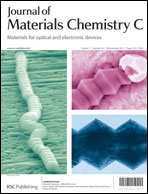Supramolecular dendrimers based on the self-assembly of carbazole-derived dendrons and triazine rings: liquid crystal, photophysical and electrochemical properties†
Abstract
Two novel families of dendrimers have been synthesized by hydrogen bonding between a triazine moiety (M), as an electron-transporting central core, and three peripheral dendrons of generations 1 and 2 derived from bis(hydroxymethyl)propionic acid (bis-MPA). The dendrons contain both carbazole-based groups as hole-transporting moieties and promesogenic units derived from 5-[4-(4-butoxybenzoyloxy)phenyloxy]pentanoic acid (family A) or cholesteryl hemisuccinate (family B) (in a 1 : 3 ratio). The formation of the complexes was confirmed by IR and NMR data. All synthesized complexes displayed mesogenic properties and their liquid crystalline properties have been investigated by means of differential scanning calorimetry (DSC), polarized optical microscopy (POM) and X-ray diffractometry (XRD). Complexes derived from CzAn dendrons (family A) exhibit nematic mesomorphism whereas complexes derived from CzBn dendrons (family B) exhibit a smectic A phase. The electrochemical behavior of the dendritic complexes was investigated by cyclic voltammetry (CV) and the dendrimers show irreversible or quasi-reversible electrochemical behavior in the range 0.0–2.0 V at a scan rate of 100 mV s−1. The UV-vis absorption and emission properties of the compounds and the photoconductive properties of the dendrons and dendrimers have also been investigated.


 Please wait while we load your content...
Please wait while we load your content...